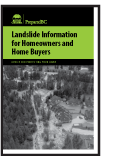Get prepared for a landslide

Landslides are the down-slope movement of rock or debris. As more homes are built onto steep slopes, landslides become a greater hazard for both people and buildings.
It’s important to take time to prepare and understand what to do before, during and after a major landslide.
Climate change and landslides
The chance of damaging landslides has increased in recent years, due in part to increases in severe wildfires, heavy rains, and flooding. Wildfires can affect topography and soil stability (PDF), contributing to flooding and landslides. Read about how B.C. is preparing for and adapting to climate change.
Be prepared
To prepare for a landslide, be aware of changes that could signal one. To report suspected landslide indicators, call the 24-hour provincial toll-free number at 1-800-663-3456, contact 9-1-1 or call your local fire, police or public works department.
You can protect yourself and your household by understanding this natural hazard and by following basic steps.
- Prepare your emergency kit. Learn more about what items to put in your kit, including quick and easy steps you can take right away
- Make a emergency plan. Consider the specific needs of all members of your household, including older adults, children, pets, and anyone with special health needs
- Limit the time that you spend in potential landslide areas, specifically during periods of fast snow melt or heavy rainfall
- Never stop your vehicle in a section of highway that has been marked as a landslide zone
- Be aware of when landslides are more likely to happen, such as during periods of heavy rainfall, fast snowmelt, or changes in temperature from below freezing to above freezing
Learn to recognize landslide or debris flow indicators, such as:
- Sudden changes in stream flow
- Rapid changes or pulses in stream flow (e.g. changes in volume) or pulses of sediment (e.g. changes from clear to murky water)
- Abnormally dirty water
- Accumulation of large logs or debris
- Rapid accumulation of sediment or bed-load along a flat section of a creek channel
- Tension cracks near the top of a slope
- Falling rocks or boulders or flowing or sliding soil. This may precede a much larger landslide
Prepare your home
If your home or property is in a landslide risk area, download guides and plans to help you develop an emergency plan and put together an emergency kit for your home and car.
- Avoid actions that would make slopes unstable
- Do not undercut a steep bank
- Do not build near the top or base of steep slopes
- Do not place fill on steep slopes
- Do not drain pools or otherwise increase water flow down steep slopes
- Learn about whether your area may be at risk of a landslide. Look out for
- existing old landslides
- steep slopes
- drainage channels on steep slopes
- streams and riverbanks
- coastal cliffs
- Know who to notify if you recognize these signs (find a local municipal contact or ask an expert to conduct an inspection such as a geotechnical engineer)
- Regularly inspect your residence, especially after heavy rainfall, rapid snowmelt, long dry spells, and earthquakes
Stay safe
Keep clear of falling debris.
If you are outdoors during a landslide, move quickly away from its likely path. Keep clear of embankments, trees, power lines, and poles.
If you are indoors during a landslide, leave immediately if you can safely do so. If you cannot safely leave the building, find cover in the section of the building that is furthest away from the approaching landslide, take shelter under a strong table or bench, and hold on until all movement has stopped.
If you are caught in a landslide with no option to evacuate to safety, curl in a tight ball and protect your head and neck.
Leave the area immediately if you observe the following:
- A faint rumbling sound that increases in volume
- Unusual sounds, such as trees cracking or boulders knocking together
Recover
Take these initial steps after a landslide to ensure your safety:
- When you are safe, report the situation by calling 9-1-1
- Stay away from the slide area as there could be subsequent slides
- Listen to local radio or television stations for the latest emergency information
- Watch for flooding, which may occur after a landslide or debris flow
- Stay away from broken utilities such as electricity and gas line
- Take photos of landslide damage in case you need them for insurance purposes
Landslide information guide
Prepare your household, protect your property and know what to do if a landslide occurs.
For more information or inquiries about this guide, please contact us at PreparedBC@gov.bc.ca.

